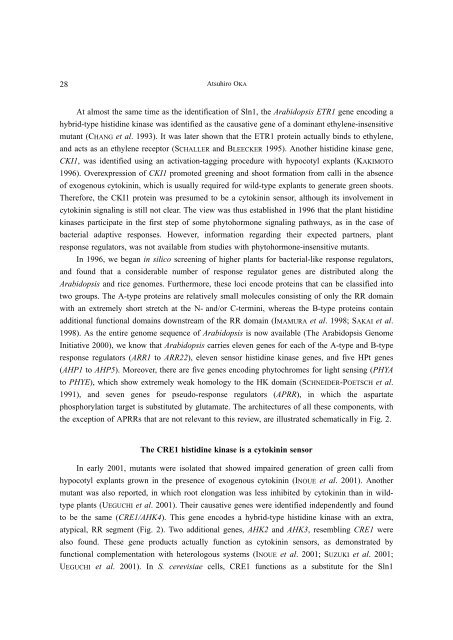No.42 - è¾²æ¥çç©è³æºç 究æ
No.42 - è¾²æ¥çç©è³æºç 究æ
No.42 - è¾²æ¥çç©è³æºç 究æ
Create successful ePaper yourself
Turn your PDF publications into a flip-book with our unique Google optimized e-Paper software.
28<br />
Atsuhiro OKA<br />
At almost the same time as the identification of Sln1, the Arabidopsis ETR1 gene encoding a<br />
hybrid-type histidine kinase was identified as the causative gene of a dominant ethylene-insensitive<br />
mutant (CHANG et al. 1993). It was later shown that the ETR1 protein actually binds to ethylene,<br />
and acts as an ethylene receptor (SCHALLER and BLEECKER 1995). Another histidine kinase gene,<br />
CKI1, was identified using an activation-tagging procedure with hypocotyl explants (KAKIMOTO<br />
1996). Overexpression of CKI1 promoted greening and shoot formation from calli in the absence<br />
of exogenous cytokinin, which is usually required for wild-type explants to generate green shoots.<br />
Therefore, the CKI1 protein was presumed to be a cytokinin sensor, although its involvement in<br />
cytokinin signaling is still not clear. The view was thus established in 1996 that the plant histidine<br />
kinases participate in the first step of some phytohormone signaling pathways, as in the case of<br />
bacterial adaptive responses. However, information regarding their expected partners, plant<br />
response regulators, was not available from studies with phytohormone-insensitive mutants.<br />
In 1996, we began in silico screening of higher plants for bacterial-like response regulators,<br />
and found that a considerable number of response regulator genes are distributed along the<br />
Arabidopsis and rice genomes. Furthermore, these loci encode proteins that can be classified into<br />
two groups. The A-type proteins are relatively small molecules consisting of only the RR domain<br />
with an extremely short stretch at the N- and/or C-termini, whereas the B-type proteins contain<br />
additional functional domains downstream of the RR domain (IMAMURA et al. 1998; SAKAI et al.<br />
1998). As the entire genome sequence of Arabidopsis is now available (The Arabidopsis Genome<br />
Initiative 2000), we know that Arabidopsis carries eleven genes for each of the A-type and B-type<br />
response regulators (ARR1 to ARR22), eleven sensor histidine kinase genes, and five HPt genes<br />
(AHP1 to AHP5). Moreover, there are five genes encoding phytochromes for light sensing (PHYA<br />
to PHYE), which show extremely weak homology to the HK domain (SCHNEIDER-POETSCH et al.<br />
1991), and seven genes for pseudo-response regulators (APRR), in which the aspartate<br />
phosphorylation target is substituted by glutamate. The architectures of all these components, with<br />
the exception of APRRs that are not relevant to this review, are illustrated schematically in Fig. 2.<br />
The CRE1 histidine kinase is a cytokinin sensor<br />
In early 2001, mutants were isolated that showed impaired generation of green calli from<br />
hypocotyl explants grown in the presence of exogenous cytokinin (INOUE et al. 2001). Another<br />
mutant was also reported, in which root elongation was less inhibited by cytokinin than in wildtype<br />
plants (UEGUCHI et al. 2001). Their causative genes were identified independently and found<br />
to be the same (CRE1/AHK4). This gene encodes a hybrid-type histidine kinase with an extra,<br />
atypical, RR segment (Fig. 2). Two additional genes, AHK2 and AHK3, resembling CRE1 were<br />
also found. These gene products actually function as cytokinin sensors, as demonstrated by<br />
functional complementation with heterologous systems (INOUE et al. 2001; SUZUKI et al. 2001;<br />
UEGUCHI et al. 2001). In S. cerevisiae cells, CRE1 functions as a substitute for the Sln1













